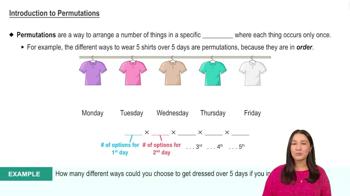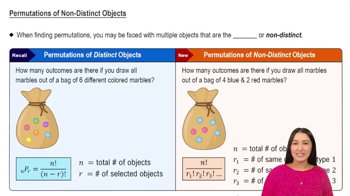Table of contents
- 0. Review of Algebra4h 16m
- 1. Equations & Inequalities3h 18m
- 2. Graphs of Equations43m
- 3. Functions2h 17m
- 4. Polynomial Functions1h 44m
- 5. Rational Functions1h 23m
- 6. Exponential & Logarithmic Functions2h 28m
- 7. Systems of Equations & Matrices4h 6m
- 8. Conic Sections2h 23m
- 9. Sequences, Series, & Induction1h 19m
- 10. Combinatorics & Probability1h 45m
10. Combinatorics & Probability
Combinatorics
Problem 9b
Textbook Question
Textbook QuestionIn Exercises 9–16, use the formula for nCr to evaluate each expression. 9C5
 Verified Solution
Verified SolutionThis video solution was recommended by our tutors as helpful for the problem above
Video duration:
3mPlay a video:
Was this helpful?
Key Concepts
Here are the essential concepts you must grasp in order to answer the question correctly.
Combination
A combination is a selection of items from a larger set where the order of selection does not matter. In combinatorial mathematics, combinations are used to determine how many ways a certain number of items can be chosen from a larger group. The notation nCr represents the number of combinations of n items taken r at a time.
Recommended video:

Combinations
Binomial Coefficient
The binomial coefficient, denoted as nCr, is a mathematical expression that calculates the number of ways to choose r elements from a set of n elements without regard to the order of selection. It is calculated using the formula nCr = n! / (r!(n-r)!), where '!' denotes factorial, the product of all positive integers up to that number.
Recommended video:
Guided course

Special Products - Cube Formulas
Factorial
A factorial, denoted as n!, is the product of all positive integers from 1 to n. Factorials are fundamental in permutations and combinations, as they help calculate the total arrangements or selections of items. For example, 5! = 5 × 4 × 3 × 2 × 1 = 120, which is essential for evaluating expressions involving nCr.
Recommended video:

Factorials

 4:4m
4:4mWatch next
Master Fundamental Counting Principle with a bite sized video explanation from Callie
Start learning



